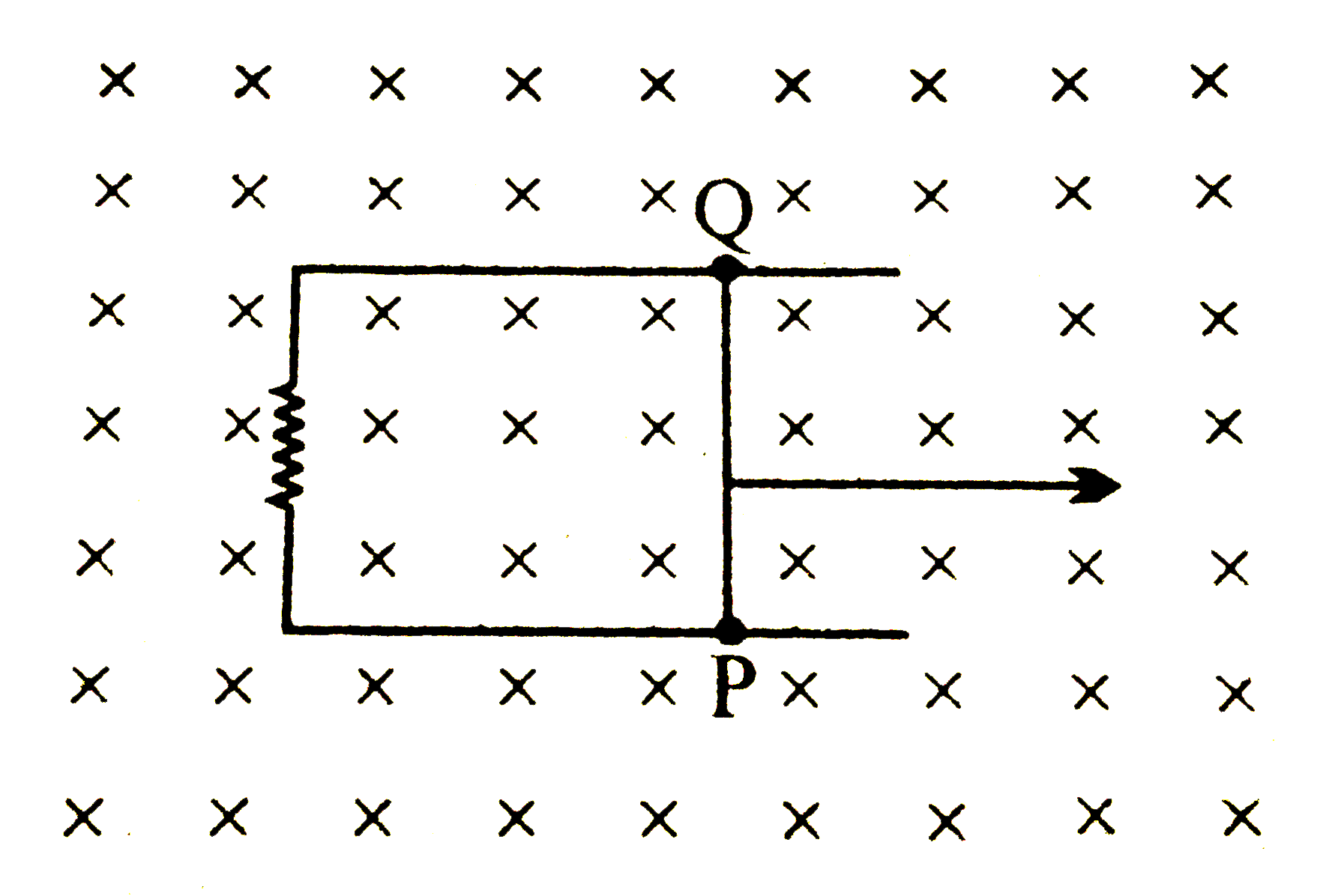A 0.5 m long metal rod PQ completes the circuit as shown. The area of the circuit is perpendicular to the magnetic field of flux density 0.15 T. If the resistance of the total circuit is 3Ω, calculate the force needed to move the rod in the direction as indicated with a constant speed of 2 m/s.
 Solution in Bengali
Solution in Bengali
Step by step video & image solution for A 0.5 m long metal rod PQ completes the circuit as shown. The area of the circuit is perpendicular to the magnetic field of flux density 0.15 T. If the resistance of the total circuit is 3Omega, calculate the force needed to move the rod in the direction as indicated with a constant speed of 2 m/s. by Physics experts to help you in doubts & scoring excellent marks in Class 12 exams.
Updated on:21/07/2023Topper's Solved these Questions
Similar Questions
Can 8.6×10−19 Coulomb of charge be given to a conductor. Explain.
View SolutionCan two equipotential surfaces intersect?
View SolutionAs shown in figure, a metal rod completes the circuit. The circuit area is perpendicular to a magnetic field with B = 0.15 T . If the resistance of the total circuit is 3 Omega , how large a force is needed to move the rod as indicated with a constant speed of 2 m/s?
View SolutionAs shown in figure, a metal rod completes the circuit. The circuit area is perpendicular to a magnetic field with B=0.15T. If the resistance of the total circuit is 3Ω, how large a force is needed to move the rod as indicated with a constant speed of 2 m/s?

View SolutionA metallic rod completes its circuit as shown in the figure. The circuit is normal to a magnetic field of B=0.15 tesla. If the resistances of the rod is 3Ω the force required to move the rod with a constant velocity of 2m/sec is-

View SolutionA 0.5m long metal rod PQ completes the circuit as shown in the figure. The area of the circuit is perpendicular to the magnetic field of flux density 0.15 T . If the resistance of the total circuit is 3Omega calculate the force needed to move the rod in the direction as indicated with a constant speed of 2 ms^(-1)
View Solution0.5 मीटर लंबी एक धात्विक छड़ चित्र में दिखाए अनुसार परिपथ को पूर्ण करती है।
परिपथ का तल 0.15 टेस्ला फ्लक्स घनत्व के चुंबकीय क्षेत्र के लंबवत है। यदि परिपथ का कुल प्रतिरोध 3Ω हो, तो छड़ को निर्दिष्ट दिशा में 2 मीटर/सेकंड की चाल से चलाने के लिए आवश्यक बल की गणना कीजिए।

View Solution0.5 मीटर लंबी एक धात्विक छड़ एक तार से जुड़कर परिपथ को पूर्ण करती है। परिपथ का तल 0.15 टेस्ला फ्लक्स घनत्व के चुंबकीय क्षेत्र के लंबवत है। यदि परिपथ का कुल प्रतिरोध 3Ω हो, तो छड़ को निर्दिष्ट दिशा में 2 मीटर/सेकंड की चाल से चलाने के लिए आवश्यक बल की गणना कीजिए।
View Solutionचित्र में धातु की 40 cm लम्बी एक छड़ PQ धातु की दो समांतर पटरियों (rails ) JK तथा LM पर दायी ओर को 5ms−1 के वेग से खिसकायी जाती है | 0.4Wbm−2 का एकसमान चुंबकीय क्षेत्र उपकरण के तल के लंबवत निचे की ओर दिष्ट है | ज्ञात कीजिये (i) PQ में प्रेरित विद्युत वाहक बल, (ii) यदि परिपथ का कुल प्रतिरोध 1.4Ω हो तो परिपथ में प्रेरित धारा व उसकी दिशा , (iii ) छड़ को गतिशील रखने के लिए आवश्यक बल तथा (iv ) परिपथ में ऊर्जा क्षय की दर |

View Solution0.5 m लम्बा एक धातु का तार PQ चित्र की भांति परिपथ पूरा करता है | परिपथ का ताल 0.15 T तीव्रता के चुम्बकीय क्षेत्र के लंबवत है | यदि सम्पूर्ण परिपथ का प्रतिरोध 3Ω हो तो तार के चित्र में प्रदर्शित दिशा में 2ms−1 की चाल से गति कराने के लिए आवशयक बल की गणना कीजिये |

View Solutionएक 0.5 m लम्बी छड़ PQ, चित्र में दिखाया परिपथ पूरा करती है। परिपथ का क्षेत्रफल, 0.15 T फलक्स घनत्व के चुम्बकीय क्षेत्र पर लम्बवत है। यदि कुल परिपथ का प्रतिरोध 3Ω हो, तो दिखाई गई दिशा में 2 m/s की स्थिर चाल से छड़ को चलाने के लिए आवश्यक बल निकालें।

View Solutionदिखायी हुई आकृति मे एक धातु की छड़ परिपथ पूर्ण करती हैं। परिपथ, चुम्बकीय क्षेत्र B=0.15 टेसला के साथ लम्बवत हैं। अगर छड़ के प्रतिरोध का मान 3Ω हैं तो छड़ को 2 मी./ सै. नियत वेग से गति में लाने के लिये आवश्यक बल होगा -

View SolutionAs shown in the figure a metal rod makes contact and complete the circuit. The circuite is perpendicular to the magnetic field with B=0.15tesla. If the resistance is 3Ω force needed to move the rod as indicated with a constant speed of 2m/sec is

View SolutionA 0.5 m long metal rod PQ completes the circuit as shown in the Fig. 6.47. The area of the circuit is perpendicular to the magnetic field of flux density 0.15 T. If the resistance of the total circuit is 3Ω, calculate the force needed to move the rod in the direction as indicated with a constant speed of 2ms−1.

View SolutionThe conducting rod ab shown in figure makes contact with metal rails ca and db. The apparatus is in a uniform magnetic field 0.800T, perpendicular to the plane of the figure.

(a) Find the magnitude of the emf induced in the rod when it is moving toward the right with a speed 7.50m/s.
(b) In what direction does the current flow in the rod?
(c) If the resistance of the circuit abdc is 1.50Ω (assumed to be constant), find the force (magnitude and direction) required to keep the rod moving to the right with a constant speed of 7.50m/s. You can ignore friction.
(d) Compare the rate at which mechanical work is done by the force (Fu) with the rate at which thermal energy is developed in the circuit (I2R).
View Solution
